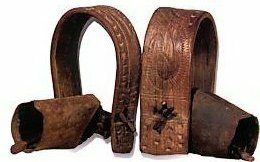|
 The most original section is for sure the one dedicated to the art of the shepherds. Peculiar to the Peloritano territory and to Calabria, this production preserves elements that connect the Sicilian prehistory with the twelfth-tenth century before Christ Apennine culture. The most original section is for sure the one dedicated to the art of the shepherds. Peculiar to the Peloritano territory and to Calabria, this production preserves elements that connect the Sicilian prehistory with the twelfth-tenth century before Christ Apennine culture.
A circumstance almost unique - and documented - of a cultural continuity beginning from more than three thousand years ago. But the cultural upsettings of the last decades and the changed customs had almost deleted this extraordinary phenomenon.
Therefore, these finds are really important, also because consituted by poor materials, not easily preservable.  They're almost all manufactured articles in wood or in horn: collars for ovines and cattle, spoons, bowls, flasks or kegs, sticks and distaffs, together with other useful utensils to the shepherd, in wood of mulberry tree, ash, logs of heather. They're almost all manufactured articles in wood or in horn: collars for ovines and cattle, spoons, bowls, flasks or kegs, sticks and distaffs, together with other useful utensils to the shepherd, in wood of mulberry tree, ash, logs of heather.
The use of the horn was usually limited to the glasses or containers for liquid, the wood of mulberry tree was used for shaped collars, from the logs of heather bowls were drawn.
Each of these objects is interesting for essentiality, elegance of the lines and for the incisions, which were made with evident references to the decorations of the cultures of the age of the bronze (XVIII-XII centuries Before Christ). The inseparable pocket knife served to affect the previously smoothed layers with geometric patterns, composing abstract lines strongly symbolic; as normal in a pastoral economy, the most familiar reference is the one of the fertility.
On the collars of the flock, may be the decorations had the practical sense of sign of recognition for the ownership of the animal, as it would be demonstrate by the fact that to old shepherds, jealous of the own collars, preferred to destroy them instead of sell them. During an assignment, against bad luck, they didn't yeld the collars.
|
![]()